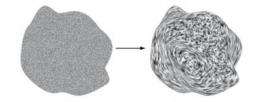New insights into how the brain reconstructs the third dimension

A new visual illusion has shed light on a long-standing mystery about how the brain works out the 3-D shapes of objects.
As dizzying as it may sound, the impression that we are living in a 3D world is actually a continuous fabrication of our brains. When we look at things, the world gets projected onto the retina and information about the third dimension is lost — a bit like when a 3D object casts a shadow onto a flat, 2D wall. Somehow the brain is able to reconstruct the third dimension from the image, allowing us to experience a convincing 3D world. A team of scientists from Giessen University, Yale and the Max Planck Institute for Biological Cybernetics in Tübingen has recently discovered how cells in visual cortex might help solve this mystery. They created special 2D patterns designed to stimulate specific nerve cells when we look at them. They find that the result is a vivid illusion of 3D shape, which suggests these cells play an important role in reconstructing 3D shape.
"We created the images by taking random noise and smearing it out across the image in specific patterns. It's a bit like finger painting, except it's done by computer", explains Roland Fleming, Professor of Psychology at the University of Giessen. "The way the texture gets smeared out is not the way texture behaves in the real 3D world. But it allows us to selectively stimulate so-called 'complex cells' in visual cortex, which measure the local 2D orientation of patterns in the retinal image".
These cells — whose discovery led to a Nobel Prize for David Hubel and Torsten Wiesel – are often described as 'edge detectors' because they respond to boundaries or edges in the image. What was not known was that these cells could play a key role in estimating 3D shape.
"We asked people to adjust small probes to report what they saw. The settings allow us to reconstruct exactly which 3D shapes they perceived," says Heinrich Bülthoff, director of the department of Human Perception, Cognition and Action at the Max Planck Institute for Biological Cybernetics. "What's striking is how close the results are to predictions of a model based on cell responses".
The authors suggest the strongest evidence implicating the cells comes from an experiment in which participants stared at patterns for 30 seconds at a time, to change the way the cells respond. The resulting 'adaptation' causes random noise—which normally looks completely flat—to appear like a specific 3D shape.
"It's a kind of aftereffect, a bit like when you stare at a waterfall for a while, adaptation makes things that are stationary look like they are moving in the opposite direction. Except here, the aftereffect makes the noise look 3D," says Daniel Holtmann-Rice, who is currently doing his PhD at Yale University. "We didn't think it was going to work. It was so exciting to get the first data where we could clearly see the predicted shapes emerging in the participants' settings."
The authors are currently working on generalizing the findings to other kinds of information about 3D shape, such as shading and highlights.
More information: Fleming, RW, Holtmann-Rice D & HH Bülthoff Estimation of 3D shape from image orientations. PNAS, published ahead of print December 6, 2011, doi:10.1073/pnas.1114619109













